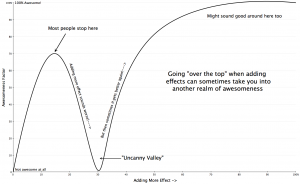 One of the dangers of nibbling away at mixing songs – commonly with your mouse rather than a dedicated audio control surface or mixing desk, is that it’s easy to be far too conservative when adding effects and the like.
One of the dangers of nibbling away at mixing songs – commonly with your mouse rather than a dedicated audio control surface or mixing desk, is that it’s easy to be far too conservative when adding effects and the like.
What typically happens is you slowly push the level of an effect up until it starts to sound like it’s too much – then you back it down slightly to get a nice balance of “wet” effect vs the “dry” sound source. Ahhhh. Nice.
This is fine – but there are often different contexts that effects work within when the balance of effect vs dry sound change radically – so by using this conservative method, you’re always remaining inside the one safe context of the sound balance without ever realising any of the other creative possibilities available.
If you keep pushing the level of the effect past the point where it sounds bad or too much, then you can sometimes get beyond the audio version of the “Uncanny Valley” into a different range of possible sounds.
A simple example is reverb. The first “conservative” range remains within the context of adding a nice subtle tail to a sound to make it blend, or perhaps to give a subtle halo of space around the sound.
As you keep pushing the reverb level up – the sound becomes muddy and cluttered as the dry sound and the reverb fight each other. This is the audio version of the “Uncanny Valley”.
If you keep pushing the reverb level even further, you will change the reverb’s context completely. The room environment is now dominant, with your instrument or voice existing within it. Of course at this point it will probably also become apparent that there will need to be some tweaking of the reverb to clean it up a bit – adjusting predelay, reverb time and perhaps applying some low-cut EQ to take out some mush.
Reverb is not the only thing that this works with – try it with any applied effect like chorus, flange, distortion, echo etc. Or try going to the extreme and remove the dry sound completely. (Try pre-fade effects sends with the fader pulled right back).
It certainly opens up many more creative possibilities and can help you discover fresh sounds for your mix to make it a little more exciting. Plus it doesn’t take much more effort or time to do this and it has zero risk! So make sure you go way over-the-top when applying effects, then just bring it back to where it works best for the song.